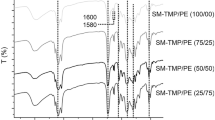Abstract
Short-oil alkyd resins were prepared by using five different oil types: corn oil, rice bran oil, sunflower oil, soya bean oil and dehydrated castor oil (DCO). Among these, soya bean oil gave alkyd resin with the darkest color because oxidation occurred. Auto air-dried coating films were developed and it was shown that film prepared from rice bran oil-based alkyd exhibited the longest drying time due to the low number of double bonds compared to other and the extra natural antioxidant in rice bran oil. DCO alkyd-based film revealed the shortest drying time, the greatest hardness but the poorest alkali and sea-water resistance. This is caused by the differences in the type of fatty acid and double bonds, the high amount of double bonds being in DCO. In addition, an increase in the reaction temperature only had an influence on darkening the alkyd color and decreasing the drying time of coating films. In terms of technical properties and cost competitiveness, soya bean oil-based film is the best. Coating films derived from all oil-based alkyds, except DCO, look promising for use in surfboard manufacturing.
Similar content being viewed by others
References
Bailey, A. E.,Industrial Oil and Fat Products, 2nd Ed., Inter-science Publishers Inc., New York, 382 (1951).
Edward, S.W.,Industrial Polymer Handbook: Product, Process, Applications, Wiley-VCH, New York, 2, 1036 (2001).
Erciyes, A. T., Erkal, F. S. and Kalipci, A., “Oil-modified alkyd type resin based on secondary esters of caster oil,”J. Coating Technol.,65, 73 (1993).
Kabasakal, O. S., Guner, F. S., Arslan, A., Ergan, A., Erciyes, A. T. and Yagci, Y., “Use of caster oil in the preparation of various oil-based binders,”J. Coating Technol.,68, 57 (1996).
Kabasakal, O. S., Guner, F. S., Erciyes, A. T. and Yagci, Y., “Styrenation of oils based on secondary esters of caster oil,”J. Coating Technol.,67, 47 (1995).
Kim, D. and Kim, S.W., “Barrier property and morphology of polypropylene/ polyamide blend film,”Korean J. Chem. Eng.,20, 776 (2003).
Parsons, P.,Surface Coating: Raw Materials and Their Usages, 3rd Ed., Chapman & Hall Inc., 1, pp. 43 and pp. 94 (1993).
Paul, S.,Surface Coatings Science & Technology, 2nd Ed., John Wiley & Sons, pp.103 and pp.129 (1996).
Xu, Z. and Godber, J. S., “Antioxidant activities of major components of γ-oryzanol from rice bran using a linoleic acid model,”J. Am. Oil. Chem. Soc.,78, 645 (2001).
Zeno, W.W., Frank, N. J. and Peter, S. P.,Organic Coatings Science & Technology, 2nd Ed., Wiley — Interscience, pp.135 and pp.142 (1996).
Author information
Authors and Affiliations
Corresponding author
Rights and permissions
About this article
Cite this article
Atimuttigul, V., Damrongsakkul, S. & Tanthapanichakoon, W. Effects of oil type on the properties of short oil alkyd coating materials. Korean J. Chem. Eng. 23, 672–677 (2006). https://doi.org/10.1007/BF02706813
Received:
Accepted:
Issue Date:
DOI: https://doi.org/10.1007/BF02706813




